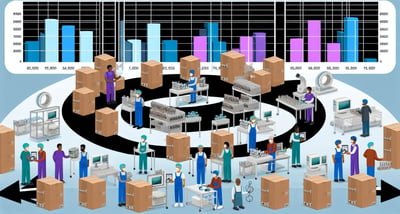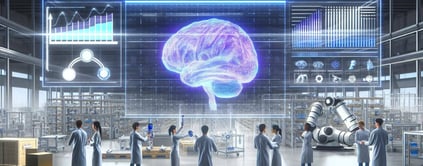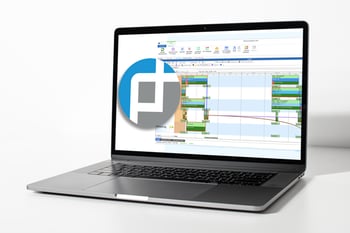Inventory Turnover Rates with AI-Driven Demand Forecasting
The demand for medical products is constantly evolving, driven by factors such as population growth, technological advancements, and changes in healthcare policies. This poses a significant challenge for purchasing managers in medical manufacturing facilities who are tasked with maintaining optimal inventory levels while ensuring products are readily available to meet customer needs. Fortunately, advancements in artificial intelligence (AI) and demand forecasting technologies offer a promising solution to this challenge.
In this blog, we'll explore how integrating AI-driven demand forecasting with enterprise resource planning (ERP) systems like SAP, Oracle, Microsoft, Kinaxis, Aveva, and others, particularly through platforms like PlanetTogether, can revolutionize inventory management processes and help medical manufacturing facilities achieve optimal inventory turnover rates.

What is Inventory Turnover Rate?
Inventory turnover rate, often referred to simply as inventory turnover, is a key performance indicator (KPI) used by purchasing managers to assess how effectively inventory is being managed. It measures the number of times inventory is sold or used in a given period, typically a year, and is calculated by dividing the cost of goods sold (COGS) by the average inventory value.
A high inventory turnover rate indicates that inventory is being replenished quickly, which can reduce carrying costs and minimize the risk of obsolescence. Conversely, a low inventory turnover rate suggests excess inventory, tying up capital and potentially leading to increased storage costs and product spoilage.

The Role of AI in Demand Forecasting
Traditional demand forecasting methods often rely on historical sales data and simple statistical techniques. While useful to some extent, these methods may struggle to capture the complexity of demand patterns in the medical manufacturing industry, where factors like seasonality, new product introductions, and regulatory changes can significantly impact demand.
This is where AI-driven demand forecasting comes into play. By leveraging advanced machine learning algorithms, AI systems can analyze large volumes of data from various sources, including sales history, market trends, weather patterns, and demographic information, to generate more accurate demand forecasts. These forecasts can help purchasing managers anticipate demand fluctuations, optimize inventory levels, and make more informed procurement decisions.

Integrating AI-Driven Demand Forecasting with ERP Systems
While AI-driven demand forecasting holds great promise for improving inventory management, its true potential can be realized through integration with ERP systems like SAP, Oracle, Microsoft Dynamics, Kinaxis RapidResponse, Aveva, and others. These ERP systems serve as the backbone of operations in many medical manufacturing facilities, managing processes such as procurement, production planning, inventory management, and order fulfillment.
Integrating AI-driven demand forecasting with ERP systems enables seamless data exchange between different modules, allowing purchasing managers to leverage demand forecasts to optimize inventory levels and streamline procurement processes. For example, PlanetTogether, a leading advanced planning and scheduling (APS) software, offers integration capabilities with various ERP systems, enabling real-time data synchronization and automated decision-making.
Benefits of Integration
The integration between AI-driven demand forecasting and ERP systems offers several key benefits for medical manufacturing facilities:
Improved Forecast Accuracy: AI algorithms can analyze vast amounts of data to generate highly accurate demand forecasts, enabling purchasing managers to anticipate changes in demand more effectively.
Optimized Inventory Levels: By aligning inventory levels with predicted demand, medical manufacturing facilities can reduce excess inventory, minimize stockouts, and improve overall inventory turnover rates.
Streamlined Procurement: Integration with ERP systems enables automated procurement processes based on demand forecasts, reducing manual intervention and streamlining order placement and fulfillment.
Enhanced Operational Efficiency: With real-time visibility into demand and inventory levels, purchasing managers can make proactive decisions to optimize resource allocation, production scheduling, and distribution.
Cost Savings: By reducing carrying costs associated with excess inventory and minimizing stockouts, medical manufacturing facilities can achieve significant cost savings and improve overall profitability.
-May-08-2024-04-36-12-8483-PM.png?width=294&height=47&name=logo%20(2)-May-08-2024-04-36-12-8483-PM.png)
Optimizing Inventory Management with AI and ERP Integration
Let's consider a hypothetical scenario where a medical manufacturing facility integrates AI-driven demand forecasting with its ERP system, using PlanetTogether as the integration platform.
By analyzing historical sales data, market trends, and other relevant factors, the AI system generates accurate demand forecasts for various products. These forecasts are then seamlessly integrated with the ERP system, updating inventory levels and triggering automated procurement processes as needed.
As a result of this integration, the medical manufacturing facility experiences:
- Improved forecast accuracy, leading to a reduction in excess inventory and stockouts.
- Streamlined procurement processes, with automated order placement and fulfillment.
- Enhanced operational efficiency, as purchasing managers can make data-driven decisions to optimize inventory levels and production scheduling.
- Cost savings due to reduced carrying costs and improved inventory turnover rates.
Optimizing inventory turnover rates is essential for medical manufacturing facilities to remain competitive and meet customer demands. By leveraging AI-driven demand forecasting and integrating it with ERP systems like SAP, Oracle, Microsoft Dynamics, Kinaxis RapidResponse, Aveva, and others through platforms like PlanetTogether, purchasing managers can achieve significant improvements in inventory management processes.
The integration of AI and ERP enables more accurate demand forecasts, optimized inventory levels, streamlined procurement processes, enhanced operational efficiency, and ultimately, cost savings and improved profitability. As medical manufacturing facilities continue to embrace digital transformation, integrating AI-driven demand forecasting with ERP systems will become increasingly crucial for staying ahead in the rapidly evolving healthcare industry.
Are you ready to take your manufacturing operations to the next level? Contact us today to learn more about how PlanetTogether can help you achieve your goals and drive success in your industry.


